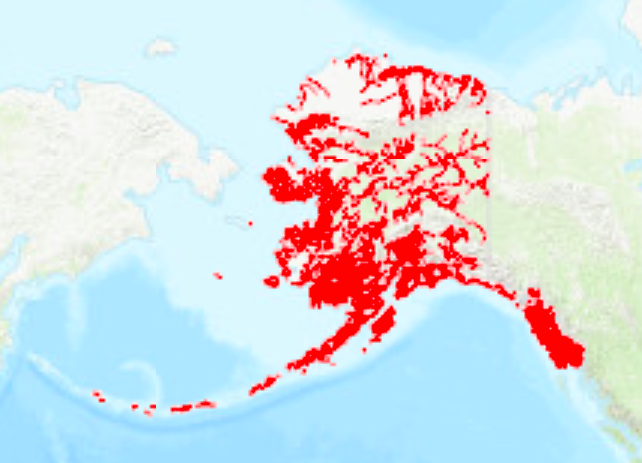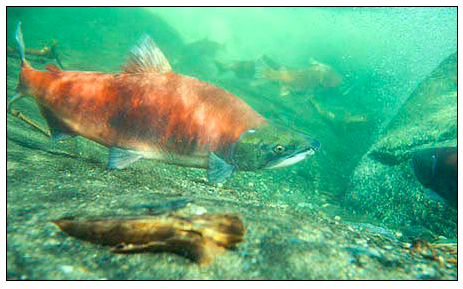Is the salmon ballot initiative constitutional? The Alaska Supreme Court heard two sides of the question on Thursday.
The Office of Lieutenant Governor argued that the initiative takes away the appropriating authority of the Legislature and is therefore unconstitutional. But the Yes for Salmon lawyer argued that it does no such thing and should go to the voters as-is, as an exercise in direct democracy.
It will be up to the judges to decide if the ballot question, as written, has constitutional problems and if it can be altered to be constitutional. One of the sticking points is if portions of the question are deleted, do those who signed the original petition need to be consulted again to see if they’re still on board?
Joanne Grace, the attorney for the State, said the case presents two issues.
The first is that the initiative prohibits the use of anadromous fish habitat for anything that permanently displaces these fish. Anadromous fish include salmon, rainbow trout, dolly varden, steelhead, eulachon and a few others that dwell part of their life cycles in the ocean, but also in streams, rivers, and lakes, which include tributaries and wetland areas.
This set of laws being proposed, she argued, is unconstitutional because it is an appropriation of resources via the ballot box.
The second question is: Can the court simply delete the unconstitutional provision of the initiative? If so, she said “all that will remain is a process without any substantive standard, and that is a very different bill than what the petition subscribers signed onto.”
The state’s lawyer told the judges that if the initiative passes as written, development of large projects such as oil, gas, and mining, would end in Alaska because any large project will have an effect on fish habitat. It would, for example, deep-six Gov. Walker’s gasline.

BALLOT INITIATIVE, AS WRITTEN
The ballot initiative is a summary of the complicated rule changes it would enact. Here’s the summary and question that voters would see:
An act providing for the protection of wild salmon and fish and wildlife habitat.
This act would amend Alaska’s fish habitat permitting law. The act would require the Department of Fish and Game (ADF&G) to issue permits for activities and development projects that have the potential to harm fish habitat. The act would exempt existing projects, operations, or facilities that have received all state and federal permits. The act would create fish and wildlife habitat-protection standards. The standards would address water quality, temperature, streamflow, and more. The act defines “anadromous fish habitat.” The act would allow ADF&G to apply the law to all habitat in Alaska that supports salmon or other anadromous fish. The act would provide for three types of permits for development in anadromous fish habitat. ADF&G could issue a general permit—a single permit that applies to many people—for certain activities. For other activities that require a permit, the act would establish a two-track permitting system. Minor permits would be issued for activities that have little impact on fish habitat. Major permits would be issued for projects that have the potential to cause significant adverse effects on fish habitat. The act defines “significant adverse effects.” The act would require ADF&G to avoid or minimize adverse effects through mitigation measures and permit conditions. It would provide public notice on all permits and a chance to comment on major permits. The act would also require ADF&G to deny a permit if the proposed activity would cause substantial damage to fish habitat. The act would create criteria, timeframes, and an appeals process for the permits. The act would allow ADF&G to respond to permit violations with tickets, civil fines, or criminal penalties. The act would repeal two current statutes. One is regarding mitigation from a dam. The other is regarding criminal penalties that are addressed elsewhere.
Should this initiative become law?
WHAT THE SUMMARY DESCRIBES IS A SUBSTANTIAL CHANGE IN LAW
The law that would change is much more detailed than what voters would see on the ballot, as seen in the summary above.
Unless voters read the underlying changes, they are not likely to understand just how far this law goes in prohibiting development of anything from docks to drilling. What is being proposed is a complicated set of statutes that the voters would be telling Fish and Game to follow, as found in the attached bill:
YES FOR SALMON – DIRECT DEMOCRACY
Valerie Brown, the attorney for the group “Yes for Salmon,” told the judges that 42,000 people had signed the petition and it was her hope that direct democracy “proceed to the ballot.”
Judging from the questions that Chief Justice Craig Stowers asked during the oral arguments on Thursday, it seems likely the state Supreme Court will uphold the lower court’s decision and voters will see the question on the November General Election ballot.

Is the Alaska Supreme Court going to be consistent or not in its application of the state constitution – that is the question.
In the most recent case of a ballot initiative attempting to allocate a natural resource (salmon) through a ban on use of a commercial fishing gear type (set nets in non-subsistence areas of the state), the Alaska Supreme Court ruled unanimously that only the Legislature has the authority to allocate state natural resources such as fish, wildlife and water.
Will the Court be consistent with its rulings, or will it be inconsistent. Pretty simple case law.
Join me and vote Yes for Salmon.
Help me out here. So is it possible the fishing industry has killed off more salmon that any other industries than say mining, or O&G? What is their end game, and how is this going to work out for our state if this becomes law?
Isn’t this the same Initiative that the LT GOV “coached” the writers on a few months ago? The one that, as submitted, would have been rejected out of hand, given an extended deadline, and ultimately approved by said LT GOV?